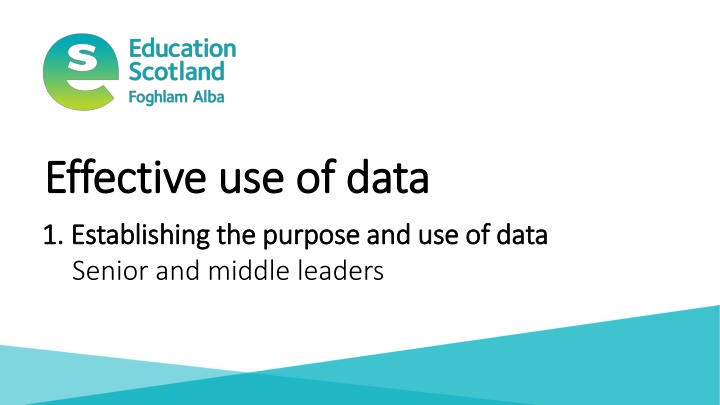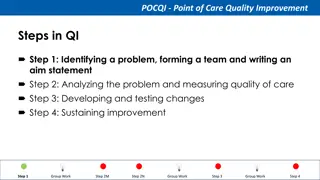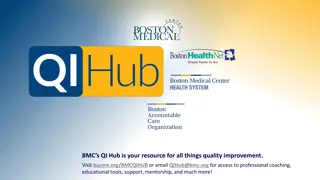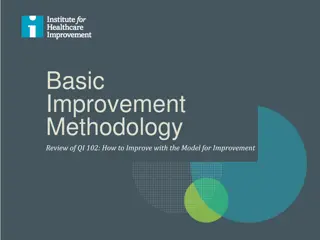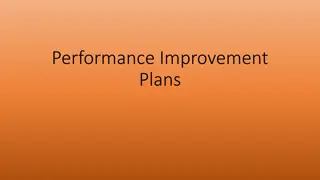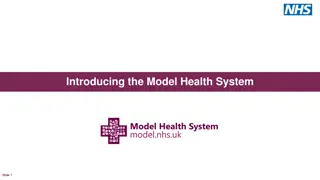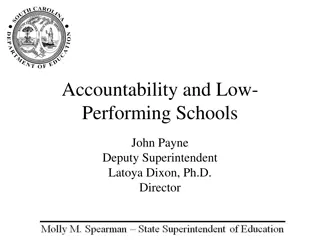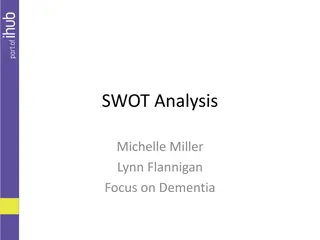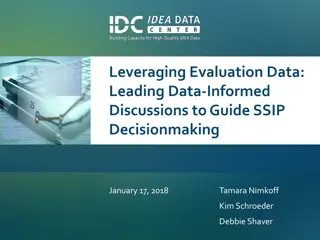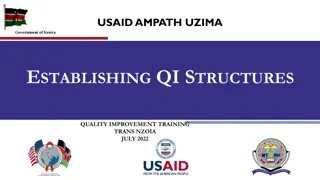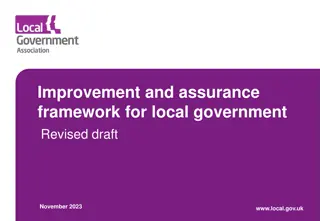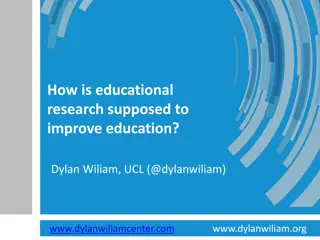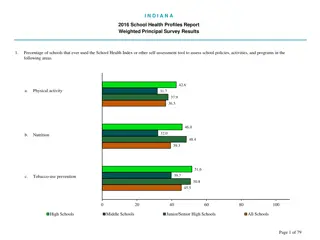Effective Use of Data for Educational Improvement
Explore the significance of data in education, differentiate between quantitative and qualitative data, understand the meaning of evidence, and delve into the role of data in addressing equity issues. The workshop covers various topics such as data definitions, the use of data for improvement, national guidance and research, data bias, and more.
Download Presentation

Please find below an Image/Link to download the presentation.
The content on the website is provided AS IS for your information and personal use only. It may not be sold, licensed, or shared on other websites without obtaining consent from the author.If you encounter any issues during the download, it is possible that the publisher has removed the file from their server.
You are allowed to download the files provided on this website for personal or commercial use, subject to the condition that they are used lawfully. All files are the property of their respective owners.
The content on the website is provided AS IS for your information and personal use only. It may not be sold, licensed, or shared on other websites without obtaining consent from the author.
E N D
Presentation Transcript
Effective use of data Effective use of data 1. Establishing the purpose and use of data 1. Establishing the purpose and use of data Senior and middle leaders
The national model of professional learning The national model of professional learning The national model of professional learning | Professional Learning | Education Scotland
Draft agreement and protocols Draft agreement and protocols We all work together We learn from, with and on behalf of each other We create a safe space to share ideas and build learning We agree that everyone is an equal and valued participant We remain in the room (follow email and phone protocol)
Connector Connector In groups or pairs: Agree on something you like. Agree on something you dislike. TASK
Aims In this workshop we will consider: the meaning of data and evidence in education what guidance and research says about the importance of data and evidence the role of data in closing the poverty related attainment gap; and the difference between big and small data.
Content coverage Data definitions and the importance of using data for improvement National guidance and research The purpose of using data Data and equity Big and small data Data bias Group activity
What is data? What is data? "Data is information, especially facts or numbers, collected to be examined and considered and used to inform decision making." Cambridge Dictionary Quantitative data refers to data that deals with numbers and can be measured. Qualitative data refers to data that deals with descriptions. It can be observed and recorded but not necessarily measured.
What is evidence? What is evidence? "Evidence can be described as information used to demonstrate impact and support decision making. Evidence can be data, in many forms, and a knowledge base about what works." Rapid Evidence Review
The importance of data The importance of data TASK Which of these quotes resonate with you and why? 1. Too many schools are not using data effectively to track and monitor at a whole school level. As a result, some schools cannot put in place appropriate strategies or interventions to address gaps. (Addressing the Poverty Related Attainment Gap, Education Scotland, 2018-20). 2. Without data you are just another person with an opinion. (W. Edward Deming) 3. The goal is to turn data into information, and information into insight. (Carly Fiorina, former CEO, HP) 4. Data use provides a lever for school improvement, but if the process isn t implemented effectively it won t deliver. (Datnow and Park, Data use for Equity , Educational Leadership, 2015.) 5. Using data is not separate from planning and from routine decisions in schools. Data is a necessary part of an ongoing process of analysis, insight, new learning and changes in practice. (Lorna M Earl and Steven Katz, 2009)
The National Improvement Framework The National Improvement Framework Where progress is good or better, senior leaders and staff track children s and young people s progress carefully. They use assessment information and data effectively to understand the progress children and young people make. Achieving Excellence and Equity - 2024 National Improvement Framework and Improvement Plan (www.gov.scot)
GTCS Standard for Middle Leadership GTCS Standard for Middle Leadership Professional responsibilities 2.2.3 know how and when to make decisions and use a wide range of robust and credible data to support and inform your judgements Self-evaluation 3.4.2 develop and sustain the effective use of a wide range of robust and credible information to support and inform decisions and improvements across the school and learning community in line with agreed strategic and operational priorities Standard for Middle Leadership
GTCS Standards for Headship GTCS Standards for Headship Professional responsibilities 2.2.3 know how and when to make decisions and use a wide range of robust and credible data to support and inform your judgements; Self-evaluation 3.4.2 develop and sustain the effective use of a wide range of robust and credible information to support and inform decisions and improvements across the school and learning community in line with agreed strategic and operational priorities The Standard for Headship
HGIOS 4 HGIOS 4 We gather a range of data and information to monitor and track progress for all learners (1.1) We regularly interrogate data (1.1) Staff make effective use of current available data on levels of child poverty and apply this to ensure equity (1.5) All teachers have well-developed skills of data analysis (2.3)
Rapid Evidence Review Paper Rapid Evidence Review Paper Section one of the Education Scotland Rapid Evidence Review on establishing the purpose and use of data highlights that: data and evidence should be used continuously and for a range of purposes throughout each stage of a school improvement cycle educators should be clear about the link between big and small data data is everyone's responsibility , and educators should be aware of the strengths, limitations and potential bias of data.
The purpose of data The purpose of data To diagnose needs Data is used to understand why learners have specific gaps. Planning for improvement is data informed. The data used is effective because it has been triangulated. To inform planning To understand progress or otherwise Data is used to track and monitor progress throughout the improvement cycle. To identify next steps Data effectively informs next steps for learners and families. To measure the impact of interventions and approaches Schools use data to evidence the impact of interventions and approaches.
The purpose of data The purpose of data part 2 part 2 To diagnose needs To inform planning To understand progress or otherwise Consider how effectively staff use data in school for a range of purposes. Discuss in groups or pairs. To identify next steps To measure the impact of interventions and approaches
Data and equity Data and equity Features of highly effective practice include: Effective use of a wide range of qualitative and quantitative data and evidence to understand the poverty-related attainment gap and the interconnections between additional support needs and poverty. Interventions are effective because they are informed by robust analysis of data. Scottish Attainment Challenge - Self- evaluation resource (education.gov.scot)
Data and Equity Data and Equity Stretch Aims Stretch Aims set high expectations, including annual, ambitious locally identified stretch aims, to help ensure significant progress is made through local stretch aims, drive improved outcomes for children and young people impacted by poverty in the local authority. The Scottish Attainment Challenge: Framework for Recovery and Accelerating Progress (www.gov.scot)
Big and small data Big and small data Read the blog post by Pasi Salberg and consider: What do we mean by big and small data? What are the strengths/limitations of big and small data? Big Data or Small Data: What s the key to unlocking learning opportunities? | Pasi SahlbergPasi Sahlberg
Big and Small Data Big and Small Data part 2 part 2 Big data in education may refer to data such as ACEL data, SCQF data or whole school surveys or questionnaires. Small data in education may refer to data such as work in jotters, observation notes, AfL information or a running reading record. It is important that all staff understand the connection between small data and big data. It is often the small data that moves the big data .
Big and Small Data Big and Small Data part 3 part 3 Big Data Small Data How does the curriculum engage boys? There is a whole school attainment gap in writing. What are their perceptions of writing? Boys appear to be making less progress than girls. Looking at jotters and assessment for learning - what are the specific gaps?
Bias Bias It is important to be aware of the potential bias in or limitations of data. What questions might you have about the example data below? 100% of girls in P4 achieved first level in writing. 95% of parents and carers said that their child was happy in school. Attendance in S3 has increased by 2%. Example data for illustrative purposes only
Group task Group task 1. Record all the different types of data and evidence gathered in school. 2. Colour code or organise the data as either big or small data. 3. As a group, organise the data by effectiveness. 4. Add a key to show: o which types of data is particularly helpful for closing attainment gaps? o which types of data is used by teachers, school leaders, support staff, learners, families or partners?
Aims review In this workshop we will consider: the meaning of data and evidence in education what guidance and research says about the importance of data and evidence the role of data in closing the poverty related attainment gap; and the difference between big and small data.
Individual Reflection Activity Individual Reflection Activity Think about the things we have covered today. What take-aways or key reflections do you have? What actions might you take? How might this impact practice in school?
Feedback Feedback Insert you own evaluation code here
